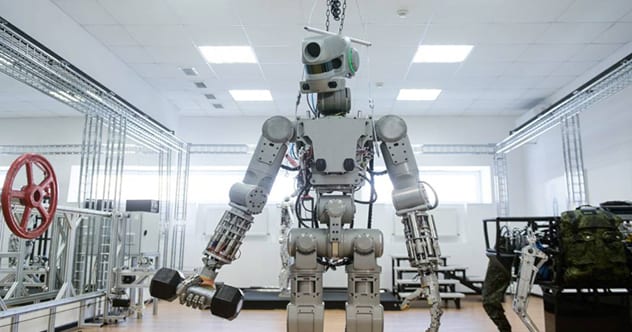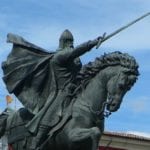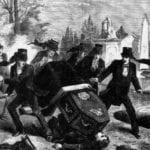 Weird Stuff
Weird Stuff  Weird Stuff
Weird Stuff  Mysteries
Mysteries 10 Tragic Disappearances and Deaths in Joshua Tree National Park
 History
History 10 Ways Childhood Really Sucked in the Old West
 Music
Music 10 Name Origins of Famous Bands from the 1990s
 Religion
Religion 10 Biggest Turnarounds by the Catholic Church
 Weird Stuff
Weird Stuff 10 Unbelievable Times Laws Had Unintended Consequences
 Humans
Humans Ten Historic Women Who Deserve Way More Credit Than They Got
 Movies and TV
Movies and TV 10 Films That Spawned Major Lawsuits
 History
History Ten Times Towns Were Wiped Off the Face of the Earth
 Creepy
Creepy 10 of the Most Disturbingly Haunted Public Houses in the UK
 Weird Stuff
Weird Stuff 10 Niche Subcultures That Are More Popular Than You Might Think
 Mysteries
Mysteries 10 Tragic Disappearances and Deaths in Joshua Tree National Park
 History
History 10 Ways Childhood Really Sucked in the Old West
Who's Behind Listverse?

Jamie Frater
Head Editor
Jamie founded Listverse due to an insatiable desire to share fascinating, obscure, and bizarre facts. He has been a guest speaker on numerous national radio and television stations and is a five time published author.
More About Us Music
Music 10 Name Origins of Famous Bands from the 1990s
 Religion
Religion 10 Biggest Turnarounds by the Catholic Church
 Weird Stuff
Weird Stuff 10 Unbelievable Times Laws Had Unintended Consequences
 Humans
Humans Ten Historic Women Who Deserve Way More Credit Than They Got
 Movies and TV
Movies and TV 10 Films That Spawned Major Lawsuits
 History
History Ten Times Towns Were Wiped Off the Face of the Earth
 Creepy
Creepy 10 of the Most Disturbingly Haunted Public Houses in the UK
10 Mad Scientists in History
The line between crazy and genius is thin, and in science, many examples of people blurring that line exist. While scientists start their experiments hoping to make striking discoveries, they can go downright apish when they don’t make a discovery. Some sacrifice their subjects while others borderline torture their volunteers. This list presents ten mad scientists in history, detailing the ambitious pursuits that led to their fame or infamy.
Related: 10 Crazy Scientific Theories That Used To Be Accepted As True
10 Paracelsus (1493–1541)
Ever wondered how you could create a man? Paracelsus was a botanist who thought there was a teeny-tiny yet fully formed human inside every sperm. He even had a 40-day recipe to prove his idea, complete with instructions to make this venture successful.
While the idea sounds preposterous in a world that has made immense discoveries in biology, Paracelsus’s idea was not as strange in his time. As a scientist from the 16th century, Paracelsus advanced the theory of preformation—which believed that organisms grew from small versions of themselves. In his instructions on creating life, Paracelsus even described how the sperm held the key to life. For the scientist, a creator only required the right incubation to develop a new human.
If you’re keen on trying out Paracelsus’s 40-day recipe on how to build a human, you’ll need a warm incubation device and human blood. But if you succeed, you’ll be the first because even Paracelsus couldn’t pull it off.
9 Josef Mengele (1911–1979)
War is tough, but what’s harder is what it reveals about the human condition: inhumanity. Joseph Mengele was a brilliant scientist whose power and influence during the Nazi era earned him an infamous reputation as the “Angel of Death.”
As a scientist assigned to the Auschwitz camps during the Second World War, Mengele performed bizarre experiments with human subjects. Some core interests of the mad scientist bordered on examining connections between twins, eye pigmentation, and persons with disabilities. The insane reality of his experiments is that he forcefully used live prisoners as guinea pigs for his experiments.
Modern scientists are horrified by the lengths that Josef Mengele went to as he attempted to study human biology. Sadly, after all his trials, they didn’t amount to anything besides shedding light on the horrors of Hitler’s reign.
8 Giovanni Aldini (1762–1834)
As far as celebrity scientists go, Giovanni Aldini was a rockstar with global fame. At a time when electricity was still a new invention, Aldini traveled across Europe with the sole purpose of electrifying subjects. This may sound horrific, and it was, but it was all in pursuit of science.
In his travels, Aldini became an entertainer who gave audiences the rare spectacle of witnessing what happens when corpses are electrocuted. In a demonstration, Aldini would attach electric nodes to observe how the body reacts. When attached to a human or ox head, the facial muscles would contort, teeth would chatter, and even eye sockets would pop out. Where the body was involved, the limbs and parts moved in motion, giving the impression that the organism was suffering or reanimating.
Yet, besides his antics, Aldini was one of the few scientists who managed to cure mentally ill patients with shocks to the brain. His curious and interesting experiments indicated the power of electricity in science.
7 William Buckland (1784–1856)
William Buckland is as mad a scientist as they come. On the one hand, he was the brilliant scientist who walked beside Charles Darwin and was the first man to describe the fossilized dinosaur, the Megalosaurus. For the English intelli-vore, science had so much to teach, and he was willing to learn and, at other times, taste it. Yes, he’s also famous as the man who could eat anything.
Besides his active pursuit of science, Buckland scoops the award for the man with a diverse palate, devouring anything from puppy, panther, and kangaroo and to sea slugs. According to his records, the most unpalatable things he ever tasted were the mole and bluebottle fly that wouldn’t just sit right with his taste buds. But, while eating every being that walks on Earth is impressive, Buckland didn’t stop there.
One famous story about Buckland is that he was once a guest at a fancy dinner where the mummified heart of Louis XI was on display. As a piece of the precious relic was passed for the guests to observe, Buckland decided to add it to his long list of culinary accomplishments. He became the mad scientist that ate the heart of a king. This is not a bragging point most scientists can claim. Nor one I would want to add to my resume.
6 Sidney Gottlieb (1918–1999)
Sidney Gottlieb is a mad scientist, by all accounts, one responsible for the CIA’s quest for mind control. As a chemist for the USA’s CIA, Gottlieb participated in some of the darkest experiments in recent history. In the 1950s and ’60s, Gottlieb was the mind behind MKUltra—a mind control program.
Some of Gottlieb’s most infamous experiments involved the use of cocaine, THC, heroin, and LSD. Gottlieb’s ruse for continuing his projects was the justification that it would help in the discovery of truth serum. However, despite all his pursuits, the LSD and other components didn’t aid interrogations but instead hindered them.
Gottlieb’s work on Project MKUltra is frowned upon, mostly because the scientist experimented on both knowing and unknowing Americans. As far as mad scientists with unquenchable power go, Gottlieb is one of the maddest.
5 Carney Landis (1897–1962)
Carney Landis was a psychology graduate at the University of Minnesota who decided to study human emotions. In his experiment, Landis hoped to spot commonalities between human reactions to various triggers.
What made Landis a mad scientist, and what led many to call him an unethical psychologist, was how he executed his experiment. In the experiment, Landis took pictures of his fellow students as they performed various acts; the more bizarre, the better. Some activities included smelling ammonia and sticking hands in buckets filled with the slimiest frogs and electric shock wires. While these instances are weird, they’re still tolerable.
The act that sent everyone through the roof was the forced decapitation of a live rat. Participants that refused to do it on their own were still captured watching Landis do it himself as he recorded their reactions. Almost all participants experienced trauma and confusion after the experiments, whose outcomes were not as convincing. The only saving grace in this story is that Landis never massacred another rodent as he went along to practice sexual psychopathology.
4 Johann Conrad Dippel (1673–1734)
Johann Conrad Dippel was your everyday scientist back when alchemy was the thing. Alchemists were practically scientists who dedicated their lives to discovering elixirs by manipulating all kinds of metals. Like his peers, Dippel was a notorious resident of Castle Frankenstein, a hilltop castle that was the stuff of myth and legend.
As the official alchemist at Castle Frankenstein, Dippel experimented with everything. The most peculiar ingredients for his elixirs included leather, ivory, blood, and horns stripped from human cadavers. While the authenticity of his elixirs was never confirmed, Dippel claimed to have found a one-all cure for all ails, from epilepsy to common colds.
But when he wasn’t solving society’s ills, the scientist was obsessed with soul transplants. Yes, corpses and grave robbers were involved. All is fair in love and science, right? Dippel had the brilliant idea that one could transfer a soul from one corpse to another using lubricant, a hose, and a funnel! Naturally, Dippel’s pursuits inspired the Frankenstein monster stories, but that’s a tale for another day.
3 Jose Delgado (1915–2011)
Jose Manuel Delgado is one of the most brilliant scientists in recent history. Before Delgado, many before him had toyed with the idea that electricity could manipulate the brain. Identifying the promise in the idea, Delgado took it to the next level, successfully controlling animals and humans with electrodes.
In what seems like a product of science fiction minds, Delgado successfully developed technologies that manipulated the mind electrically using a brain chip. Like the movies, Delgado stimulated the neural tissues of monkeys, controlling them with nothing but remote control. Gradually, the mad scientist perfected the technology and used it on a bull. The experiment was incredible since he was able to stop the bull right before it charged straight for him!
The experiments were so advanced that at least 20 humans were involved in his experiments. Envisioning the success of his technology, Delgado even bragged that generals and their armies would soon be controlled remotely through electric brain stimulation. He was truly ahead of his time, or maybe that’s just the electrode implants speaking.
2 Robert Knox (1791–1862)
Anatomy was one of the most prestigious pursuits for scientists of the 19th century. In this market, Robert Knox was a legend, a true pioneer of comparative anatomy who also doubled as a lecturer. Sadly, like all mad scientists, Knox went to some depths that destroyed his stellar reputation.
Since anatomy requires one major component, bodies, Knox relied on two suppliers. At the time, demand outweighed supply, and the two gentlemen, Burke and Hare, resorted to killing people and supplying them to Knox. Gradually, the law caught up with the gentlemen after their exploits were too successful. Investigations revealed that they were responsible for a 16-person killing spree where Knox was indirectly implicated alongside the crooked body snatchers.
The accepted “ask no question” practice toward cadavers bit Knox, whose reputation took a huge hit. The incident was so grand that from the media frenzy, the authorities came up with the Anatomy Act of 1832. The pursuit of cadavers truly killed Robert Knox’s career.
1 Ilya Ivanovich Ivanov (1870–1932)
In science, there’s nothing like too far, and Ilya Ivanovich Ivanov subscribed to this creed. Ivanov created the strangest and creepiest hybrids as a Russian specialist in interspecific hybridization and artificial insemination. To carry out his unholy experiments, Ivanov even traveled to Guinea, West Africa, where he hoped to cross-breed humans and apes.
When Russia sought worldwide dominion, the state saw Ivanov’s experiments as key to discovering super-strong hairy warriors. Backed with financial and political support, Ivanov set out on the secret mission that collapsed soon after. Fortunately, Ivanov found it impossible to create a hybrid between humans and our ape relatives.
Yet, despite the failures of his ape-human project, Ivanov was successful in other ventures. He created a zeedonk (zebra-donkey hybrid), a zubron (bison-cow hybrid), a guinea-pig rabbit, an antelope-cow, and even a mouse-rat. These bizarre incarnations made him a legend within scientific circles, but he never could overcome the negative publicity from the ape-human trials. As far as experiments go, we’re sure glad some failed.








